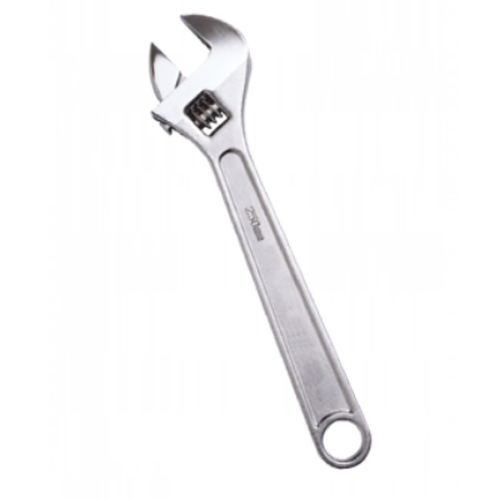When it comes to wrenches, two popular types often come into play: the pipe wrench and the adjustable wrench . Both are essential tools for various tasks, but they serve different purposes. Understanding the differences between these wrenches can help you choose the right one for your job.
Pipe Wrench: The Heavy-Duty Workhorse

A pipe wrench is a specialized tool designed for gripping and turning pipes. Its serrated jaws are made to dig into the surface of a pipe, providing a strong grip that allows you to turn and tighten even the most stubborn fittings. The adjustable head can be sized to fit different pipe diameters, making it an essential tool in plumbing.
- Uses: Pipe wrenches are ideal for working with metal pipes, especially in plumbing tasks where you need to grip and turn cylindrical objects. They are often used to install or remove pipes and fittings, particularly in tight spaces where leverage is crucial.
- Advantages: The pipe wrench’s strong grip and adjustable jaws make it perfect for heavy-duty tasks. Its design ensures that the wrench won’t slip, even on smooth surfaces, making it indispensable in plumbing and other mechanical work.
When to Use a Pipe Wrench:
- Plumbing work: Pipe wrenches are specifically designed for pipes, making them indispensable for plumbing tasks.
- Gripping round surfaces: The serrated teeth of the wrench can grip smooth, round objects like metal pipes or fittings.
- Heavy-duty applications: Due to its strong grip and long handle, the pipe wrench is perfect for tough jobs requiring a lot of torque.
However, keep in mind that the sharp teeth on a pipe wrench can damage surfaces, particularly softer materials. It is best suited for metal pipes, not for delicate or small tasks.
Adjustable Wrench: The Versatile Tool

An adjustable wrench, also known as a crescent wrench, is a more general-purpose tool. It features a movable jaw that can be adjusted to fit a wide range of bolt and nut sizes. Unlike the pipe wrench, an adjustable wrench is designed for flat-sided objects, such as hex nuts and bolts.
- Uses: Adjustable wrenches are versatile and can be used for various tasks, from assembling furniture to automotive repairs. Their ability to adjust to different sizes makes them a must-have in any toolbox.
- Advantages: The adjustable wrench’s versatility is its main advantage. It can replace a set of fixed-size wrenches, saving space and offering convenience. Its smooth jaws are less likely to damage the surfaces of nuts and bolts, making it ideal for delicate tasks.
When to Use an Adjustable Wrench:
- Tightening or loosening nuts and bolts: This tool is excellent for working with bolts, especially when you don’t have a set of fixed-size wrenches.
- Versatility: The adjustable wrench can handle a variety of fastener sizes, making it an essential tool for general repairs.
- Household tasks: From assembling furniture to fixing bicycles, this wrench can handle various tasks around the house.
The adjustable wrench, however, doesn’t provide the same gripping power as a pipe wrench and may not be suitable for heavy-duty tasks involving large pipes or high torque.
Pipe Wrench vs. Adjustable Wrench: Key Differences
- Design:
- A pipe wrench has serrated jaws for gripping pipes and round surfaces.
- An adjustable wrench has smooth jaws, adjustable to fit different sizes of nuts and bolts.
- Primary Use:
- Pipe wrenches are best for plumbing and tasks involving metal pipes.
- Adjustable wrenches are more versatile and are great for general household tasks and working with flat-sided fasteners.
- Strength and Torque:
- Pipe wrenches provide greater torque and leverage, making them ideal for jobs that require significant force.
- Adjustable wrenches are better suited for precision work, where a light touch is required.
- Potential for Damage:
- The pipe wrench’s serrated teeth can leave marks on pipes or fittings, especially on softer materials.
- The adjustable wrench’s smooth jaws are less likely to damage the surface of the fasteners.
Which Wrench Should You Use?
The choice between a pipe wrench and an adjustable wrench ultimately depends on the type of job you’re tackling. If you are working on plumbing, where pipes need to be securely tightened or loosened, a pipe wrench is your best bet. It provides the grip and torque required for such tasks.
However, if your task involves tightening or loosening nuts and bolts, or if you’re performing general maintenance around the house, the adjustable wrench is more versatile and suitable. Its smooth jaws won’t damage surfaces, and its adjustable size makes it a convenient option for various tasks.
Conclusion
Both wrenches have their place in a well-rounded toolkit. Whether you’re a professional plumber or a DIY enthusiast, having the right wrench for the job can make all the difference.
For high-quality pipe wrenches, adjustable wrenches, and other essential tools, visit JCBL Hand Tools, where you’ll find a range of durable and reliable tools tailored to your needs.
